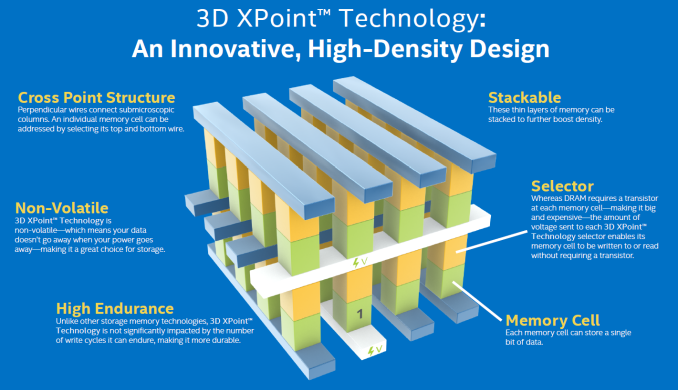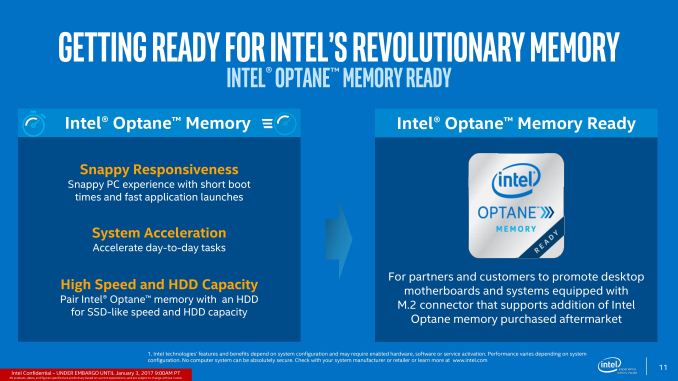Intel Launches 7th Generation Kaby Lake: 15W/28W with Iris, 35-91W Desktop and Mobile Xeon
by Ian Cutress on January 3, 2017 12:01 PM ESTOptane Memory: Support for Intel 3D XPoint
For our regular readers, 3D XPoint will be well known, but for everyone else here’s a quick recap. One of the goals in the memory industry is to create something with the speed of DRAM but persistent, such that the data is saved when the power is switched off. DRAM uses power to refresh data, but is a bulk-source of data movement for software. A lot of the speedup behind software is the speed behind memory accesses, or the ability to have data closer to the core when needed, so having a large, close, non-volatile memory set can be a big help in both performance and power consumption. In order to create non-volatile memory like this, several players have spent the best part of a decade creating new materials and new paradigms to get something that works. Intel (and Micron) formally announced their 3D XPoint solution over a year ago, allowing for a bit-level addressable matrix of non-volatile memory, however no products have formally been announced.
Intel intends to create three levels of 3D XPoint, suitable for different parts of the storage chain:
#1 - Storage (‘Optane SSD’): 120GB+ of SSD like NVMe storage
#2 - Storage Caching (‘Optane Memory’): 16-32GB of HDD Caching storage
#£ - DRAM (‘Optane DRAM’ ?): ?GB of DRAM, DDR4-pin compatible
The first two in that list have been defined, although the use of the term ‘Memory’ to define a storage cache is a little odd. Intel has stated in briefings that ‘Optane Memory’ is different to ‘Optane SSD’, and no exact word yet on how the 3D XPoint DRAM product will be named.
We saw a pair of the Optane SSD evaluation drives at IDF. These are drives that Intel hands out to large partners and OEMs to help configure future products or optimize software, and we were told these were early-production 140GB drives which may or may not represent what’s coming to market. Unfortunately aside from a few images of a heatsink several inches away, we were unable to look any deeper in to the design at the time.
Optane Memory, as announced through the recent Lenovo announcement, forms the brand name for a series of caching drives. We’ve had caching drives before, when SSDs were coming to the market and a combination of Intel RST, an mSATA drive and a spinning HDD meant that some elements of the storage were cached, affording a higher rate of performance over a regular HDD. The same concept applies here, with the 16GB Optane Memory drives acting as a cache for certain elements of the HDD use case enabling faster speeds when needed. We are told that this requires an update to Intel RST, and that Optane Memory will only work on Kaby Lake and up with a 200-series chipset (as in, you can’t use it with a 200-series chipset and Skylake, for example). The benefits of having Optane as a cache over a regular SSD are unclear at this point, aside from the fact that Optane will be under NVMe and use PCIe lanes – Billy Tallis, our SSD editor, has written a piece on the situation which is worth a read.
One thing that Intel mentioned during our Kaby Lake briefings is that ‘Optane Memory’ is different from ‘Optane SSD’, which could lead one to believe that ‘Optane Memory’, as a caching drive, cannot be used as an SSD. The original caching of an mSATA drive was almost like a hybrid RAID setup, and the mSATA drive could still be used as an SSD if it was configured that way. Because Intel is giving this a different naming system, it might stand to reason that the Optane caching drive cannot be used as a separate SSD in itself. Intel also stated that it will be later in the first half of 2017 before these drives are available as a separate purchase.
As of right now, only Lenovo has announced laptops with Optane Memory installed, however we expect several more vendors to announce products over the next few weeks unless Lenovo has initial exclusivity. So while Optane Memory is an advertised feature of Kaby Lake and the 200-series chipsets, it is one that users will have to wait to get to grips with, if relevant at all.












43 Comments
View All Comments
Lolimaster - Tuesday, January 3, 2017 - link
It's the same damn skylake with a more "mature" process. Before you could call that "release new models" like FX8350 and later the 8370.Calling it a new generation is laughable. Haswell refresh got the 4790K after the initial 4770K,
marc1000 - Friday, January 6, 2017 - link
even as some specific benchmarks show 20% to 30% improvements over 2600k, when I look at gaming I loose all interest to upgrade. my computer is either idle (browsing or light use) or is gaming. to 90% of users with a "generic" profile, there is hardly any reason to leave a Sandy-bridge computer.of course, ultra-thin notebooks and other low-power equipments can put the newer cpus to good use. but wherever a 2600k can already fit, there is no reason to change it. I am keeping my 2500k for yet another cycle here... (maybe this is the result of a lack of competition for some years???)
@Ian, if possible please include a comparison of a 2500k or 2600k Sandy at 4Ghz vs the newer 7600 or 7700 processors. if this is possible of course.
limitedaccess - Tuesday, January 3, 2017 - link
So $305 is the official MSRP? This makes it cheapest mainstream i7 k series release yet?According to Anandtech's review even the first 2600k had a higher $317 MSRP, 3770k was the previous lowest at $313.
Ken_g6 - Tuesday, January 3, 2017 - link
Ars Technica says it's $350, not $305. Typo?http://arstechnica.com/gadgets/2017/01/intel-core-...
limitedaccess - Tuesday, January 3, 2017 - link
Looking at some other reviews, Tom's, Techreport and PCPer say $339.cfenton - Tuesday, January 3, 2017 - link
On the final page it says, "At the end of the day, the Core i7-7700K... has a tray price of $305. This means it will probably reach shelves around $330-$350, and we haven’t heard about a new stock cooler so it will probably come without one."So $305 is the tray price and retail will be $330-$350.
Casper42 - Tuesday, January 3, 2017 - link
> I highly suspect that the Xeon CPUs will be announced later in Q1, given that the target market for these is a little different to standard desktop processors.Late March
chucky2 - Tuesday, January 3, 2017 - link
I hope in the chipset review piece you're doing later, you address what future CPU's will be supported under series 200 socket 1151 motherboards. For example, is Intel committing to Coffee Lake support on these boards? Cannonlake? I.e. How much longevity are we going to get with these boards? Same same on the Xeon boards front for it's chipset.TEAMSWITCHER - Tuesday, January 3, 2017 - link
I'm thinking the longevity will be very short. Z270 is to Z170 ... just as ... Z97 was to Z87. Intel's 10 nm processors will probably introduce a new socket.chucky2 - Wednesday, January 4, 2017 - link
If Z270 really is like Z97, that will be a complete joke.I'm starting to wonder if the physical limits have basically been reached, and we're slowly (whether by Corp design or physics, or, some of both), just hitting the wall and this is essentially it.